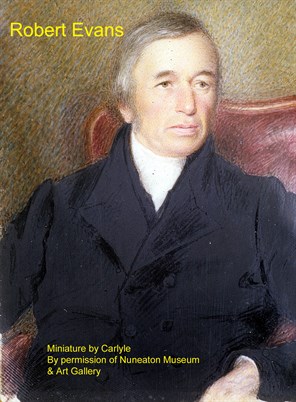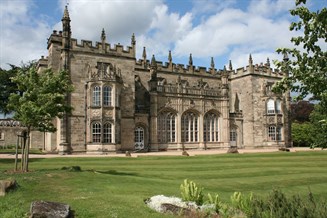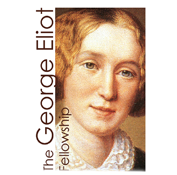Her Life
The George Eliot Fellowship
Childhood
Mary Anne Evans was born on the 22nd November 1819 at South Farm on the Arbury estate, on the outskirts of Nuneaton, Warwickshire, the third of five children of parents Robert and his second wife, Christiana.
 Robert Evans was manager of the large estates of the Newdigate family at Arbury Hall, situated over Warwickshire's richest coalfield. He was born at Roston Common in Derbyshire, the fourth son of the village carpenter. Having received a basic education at the village school run by Bartle Massey, whose name is later given to the schoolmaster in Adam Bede, he was apprenticed to his father's trade. Robert Evans established his own carpentry business in neighbouring Ellastone, Staffordshire where he was employed by the local landowner Frances Parker. On inheriting the Arbury estate in Nuneaton in 1806 following the death of his cousin Sir Roger Newdigate, Parker (who became Francis Newdigate) took Robert Evans with him to manage the 7000 acre estate.
Robert Evans was manager of the large estates of the Newdigate family at Arbury Hall, situated over Warwickshire's richest coalfield. He was born at Roston Common in Derbyshire, the fourth son of the village carpenter. Having received a basic education at the village school run by Bartle Massey, whose name is later given to the schoolmaster in Adam Bede, he was apprenticed to his father's trade. Robert Evans established his own carpentry business in neighbouring Ellastone, Staffordshire where he was employed by the local landowner Frances Parker. On inheriting the Arbury estate in Nuneaton in 1806 following the death of his cousin Sir Roger Newdigate, Parker (who became Francis Newdigate) took Robert Evans with him to manage the 7000 acre estate.
Robert was a man of legendary physical strength, great practical ability and unimpeachable honesty. His duties at the Arbury estate were wide-ranging: he surveyed land and buildings, managed the tenant farmers, collected rents and was involved in negotiations with road-builders and coal-mining businesses in the area. His knowledge and integrity were so widely respected that he was often called upon as an arbiter in disputes. Robert was also relief officer for the estate: he distributed assistance to the poor, helped administer the workhouse and called Newdigate's attention to the need to reduce the rent when the harvest was poor. From him, his daughter Mary Anne acquired a sympathy and sense of responsibility for the welfare of working families.
 South Farm (known in 1819 as Arbury Farm) from a watercolour by Patty Townsend c 1885, and as it appears today. It can only be visited on a George Eliot Fellowship Tour.When Mary Anne was four months old the Evans family moved to Griff House, Nuneaton, a spacious eight bedroomed, red-brick house with stables, outbuildings, dairy, a farmyard and an orchard, situated just off the main road between Nuneaton and Coventry. In 1876 when George Eliot received a photograph of Griff, she wrote:
South Farm (known in 1819 as Arbury Farm) from a watercolour by Patty Townsend c 1885, and as it appears today. It can only be visited on a George Eliot Fellowship Tour.When Mary Anne was four months old the Evans family moved to Griff House, Nuneaton, a spacious eight bedroomed, red-brick house with stables, outbuildings, dairy, a farmyard and an orchard, situated just off the main road between Nuneaton and Coventry. In 1876 when George Eliot received a photograph of Griff, she wrote:
"Dear old Griff still smiles at me which is more like than unlike its former self, and I seem to feel the air through the attic above the drawing room, from which, when a little girl, I often looked towards the distant view of Coton 'College' (the workhouse) thinking the view rather sublime."
The twin sons who arrived fourteen months after Mary Anne, died shortly after birth. Christiana never enjoyed good health during Mary Anne's childhood and was to die when Mary Anne was sixteen years old. Many have remarked on the absence of significant mothers among the characters in George Eliot's fiction. Her brother later recalled to Eliot's first biographer, her widower, John Cross that he had been his mother's favourite and that Chrissey, their elder sister was the favourite of the aunts as she, unlike Mary Anne, was always neat and tidy. The many depressions in Eliot's life, her low self esteem and self doubt may have stemmed from a poor relationship with her mother, but fortunately for Mary Anne she was her father's favourite. Clever, interested in everything he did, she was a good companion for Evans who would take her with him as he drove on his rounds. While Evans transacted his business his daughter would sit with the housekeeper at Arbury Hall and listen to the servants' stories. She did the same when he went to nearby Astley Castle to see Colonel Newdigate, the son of his employer.
 Mrs Wallington's boarding school in NuneatonMary Anne's great companion was her older brother Isaac. In an idyllic rural childhood they roamed the fields around Griff and fished in the canals and the 'Round Pond'. In her last published work Impressions of Theophrastus Such (1879) George Eliot describes her native country as 'fat central England' with its elms, buttercups, and tree-studded hedgerows, but she also remembers the coal-mining, the building of roads and railways and the cutting of canals to take the coal from the mines. Many of the local villagers worked in the pits and lived in poor cottages on the Newdigate estate. A depiction of the two children growing up in rural 'middle' England is to be found in the early chapters of The Mill on the Floss, the most autobiographical of Eliot's novels.
Mrs Wallington's boarding school in NuneatonMary Anne's great companion was her older brother Isaac. In an idyllic rural childhood they roamed the fields around Griff and fished in the canals and the 'Round Pond'. In her last published work Impressions of Theophrastus Such (1879) George Eliot describes her native country as 'fat central England' with its elms, buttercups, and tree-studded hedgerows, but she also remembers the coal-mining, the building of roads and railways and the cutting of canals to take the coal from the mines. Many of the local villagers worked in the pits and lived in poor cottages on the Newdigate estate. A depiction of the two children growing up in rural 'middle' England is to be found in the early chapters of The Mill on the Floss, the most autobiographical of Eliot's novels.
 Mrs Wallington's boarding school in NuneatonWhen Isaac was eight he was sent away to school. Mary Anne was also sent as a boarder aged five years old to a school less than a mile from Griff. She was dreadfully homesick. John Cross in his biography describes the five year old schoolgirl shivering outside the circle of larger girls blocking the narrow fireplace. Even then, the other girls seemed to recognise her outward gravity and inner vulnerability.
Mrs Wallington's boarding school in NuneatonWhen Isaac was eight he was sent away to school. Mary Anne was also sent as a boarder aged five years old to a school less than a mile from Griff. She was dreadfully homesick. John Cross in his biography describes the five year old schoolgirl shivering outside the circle of larger girls blocking the narrow fireplace. Even then, the other girls seemed to recognise her outward gravity and inner vulnerability.
A year later Mary Anne was moved to a larger boarding school, Mrs Wallington's, also in Nuneaton, where one of her teachers was the gentle evangelical Maria Lewis with whom she was to have a close friendship for fourteen years. In Miss Lewis, Mary Anne found the first person to perceive her intellectual gifts and also to provide the sympathetic mother figure she craved. Her reading and conversation with Miss Lewis, and later, their extensive correspondence reveal an interest in philosophy and ethics extraordinary in a young girl.
 Nant Glyn SchoolIn 1832 Mary Anne was sent to one of the best schools in the Midlands, Nant Glyn school run by the Miss Franklins, daughters of a well-known local minister, Francis Franklin of the Cow Lane Baptist Chapel in Coventry (the model for Rufus Lyon in Felix Holt). Here she gained in confidence; her intelligence and diligence were regarded as good, not eccentric qualities. Franklin girls were encouraged to read widely: Shakespeare, Milton, Pope, Byron and Wordsworth. From the start Mary Anne's work was outstanding: she shone at painting, English composition, French and piano playing. Her first piece of historical fiction Edward Neville was written at the age of 14 years old. The fragment shows that already here was a girl who loved recreating the past with eloquent and vivid descriptions of clothes and castles. It also shows the influence of the novels of Walter Scott.
Nant Glyn SchoolIn 1832 Mary Anne was sent to one of the best schools in the Midlands, Nant Glyn school run by the Miss Franklins, daughters of a well-known local minister, Francis Franklin of the Cow Lane Baptist Chapel in Coventry (the model for Rufus Lyon in Felix Holt). Here she gained in confidence; her intelligence and diligence were regarded as good, not eccentric qualities. Franklin girls were encouraged to read widely: Shakespeare, Milton, Pope, Byron and Wordsworth. From the start Mary Anne's work was outstanding: she shone at painting, English composition, French and piano playing. Her first piece of historical fiction Edward Neville was written at the age of 14 years old. The fragment shows that already here was a girl who loved recreating the past with eloquent and vivid descriptions of clothes and castles. It also shows the influence of the novels of Walter Scott.
 Nant Glyn School is now Loveitts the Estate AgentsMary Anne continued to take the evangelical tenets of the Christian faith very seriously, although she would have been alert to the challenges presented by science to religious belief. The railway would not reach Coventry or Birmingham until 1836 but rocks and fossils were being discovered from the excavations for railway construction that were revealing that the world could not have been created in six days as was claimed by the Bible. Nevertheless Mary Anne continued to display her religious zeal at the Franklins' school, and her Calvinism seems to have been stricter than her teachers. Her growing puritanical fervour, which included a neglect of her personal appearance in order to avoid vanity and self-indulgence, increased her alienation from Isaac who, like their father, held conservative, High Church views.
Nant Glyn School is now Loveitts the Estate AgentsMary Anne continued to take the evangelical tenets of the Christian faith very seriously, although she would have been alert to the challenges presented by science to religious belief. The railway would not reach Coventry or Birmingham until 1836 but rocks and fossils were being discovered from the excavations for railway construction that were revealing that the world could not have been created in six days as was claimed by the Bible. Nevertheless Mary Anne continued to display her religious zeal at the Franklins' school, and her Calvinism seems to have been stricter than her teachers. Her growing puritanical fervour, which included a neglect of her personal appearance in order to avoid vanity and self-indulgence, increased her alienation from Isaac who, like their father, held conservative, High Church views.
As Brenda Maddox writes in her biography of George Eliot, 'Mary Anne's personal combination of strong intellect, wide reading and low self-esteem made her vulnerable to a doctrine of self-effacement and duty towards others. She also acquired a lifelong interest in the dilemmas of clergymen struggling to be true to faith and flock. Clerics would be among the most vivid characters in her fiction'.
At Christmas 1835, Mary Anne's formal education came to an end. Her mother was dying of cancer and her father also suddenly became seriously ill. Mary Anne and her older sister Chrissey nursed them both; their father recovered but their mother died. Nowhere does George Eliot write openly of this long illness and grim death which must have put a terrible strain on a sensitive and imaginative sixteen year old. From then on, Mary Anne was needed to help her sister run Griff House.
 Arbury Hall - open to the public over Bank Holiday weekends, or by special arrangement with the George Eliot Fellowship for parties of 25 or more.In May 1837 Chrissey married. It is signing her name as a bridesmaid in the register that we notice that Mary Anne now spells her name 'Mary Ann', the first of many changes to her name through her life as she embraced or adjusted to the various vicissitudes of her life. Refusing her father's offer to employ a housekeeper, Mary Ann was now in charge of managing the large house and dairy. Indeed she did more than manage: she would make currant jelly, mince pies, damson cheese and butter. She later used to say that her right hand was larger than her left because of all her butter churning and cheese making. It is significant that her second novel, Adam Bede is dominated by the character and destiny of the beautiful young dairymaid Hetty Sorrel.
Arbury Hall - open to the public over Bank Holiday weekends, or by special arrangement with the George Eliot Fellowship for parties of 25 or more.In May 1837 Chrissey married. It is signing her name as a bridesmaid in the register that we notice that Mary Anne now spells her name 'Mary Ann', the first of many changes to her name through her life as she embraced or adjusted to the various vicissitudes of her life. Refusing her father's offer to employ a housekeeper, Mary Ann was now in charge of managing the large house and dairy. Indeed she did more than manage: she would make currant jelly, mince pies, damson cheese and butter. She later used to say that her right hand was larger than her left because of all her butter churning and cheese making. It is significant that her second novel, Adam Bede is dominated by the character and destiny of the beautiful young dairymaid Hetty Sorrel.
 As a well-off young woman, most afternoons would be taken up paying and receiving calls. Mary Ann often visited Chrissey in Meriden and in the evenings would read to her father and play the piano to him. Robert was proud of his daughter and respected her abilities. Recognising his daughter's exceptional intelligence he ordered all the theological books she required from London and ensured she had tutors from Coventry in Music, German and later Italian.
As a well-off young woman, most afternoons would be taken up paying and receiving calls. Mary Ann often visited Chrissey in Meriden and in the evenings would read to her father and play the piano to him. Robert was proud of his daughter and respected her abilities. Recognising his daughter's exceptional intelligence he ordered all the theological books she required from London and ensured she had tutors from Coventry in Music, German and later Italian.
Mrs Charles Newdigate, now mistress of Arbury Hall, invited Mary Ann to use the library of the great house. In a century when women could not go to university, the role Arbury Hall played in her development cannot be underestimated. In her first novel, Scenes of Clerical Life, composed of three novellas based on her memories of growing up in Nuneaton, the second story Mr Gilfil's Love Story is set at Arbury Hall which she called 'Cheverel Manor'. With Mrs Newdegate, Mary Ann distributed clothing and blankets to the poor on the estate. She herself was responsible for visiting forty-two families.

